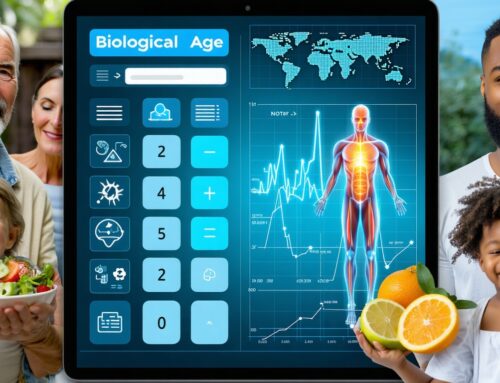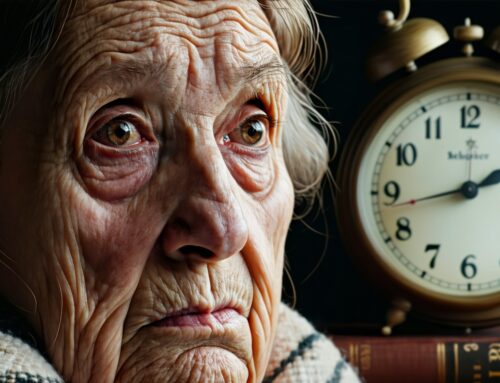Understanding Biological Age
Exploring Geroscience
Geroscience is all about figuring out what makes us age and how we can slow it down. It’s like the science version of finding the fountain of youth. The goal is to keep you spry and lively, avoiding those pesky frailties and disabilities that come with getting older. By diving into the nitty-gritty of aging, geroscience aims to boost your quality of life as you grow older.
One of the big things geroscience focuses on is finding biomarkers of aging. These are like little clues that tell you how your body is holding up as the years go by. Some of the main things geroscience looks at include:
- Mitochondrial dysfunction (your cell’s powerhouses getting tired)
- Proteostasis (keeping your proteins in check)
- Stem cell dysfunction (your body’s repair crew slacking off)
- Nutrient sensing (how your body knows what to eat)
- Genomic instability (your DNA getting a bit wobbly)
- Telomere dysfunction (the ends of your chromosomes fraying)
- Cellular senescence (cells that refuse to retire)
- Epigenetic changes (your genes getting a makeover)
Getting a handle on these can help you make smart choices about your health and how long you stick around. Curious about how biological age stacks up against chronological age? Check out our article on biological age vs chronological age.
Biomarkers of Aging
Biomarkers are like the body’s report card, showing how well things are ticking along. They give you a peek into your biological age and can hint at your risk for those annoying age-related diseases. Here are some key players in the biomarker game:
Inflammatory Markers
Inflammation is like the body’s alarm system, but when it won’t shut up, it can lead to trouble. Chronic inflammation is a hallmark of aging and is tied to a bunch of diseases. Checking out markers like C-reactive protein (CRP) and interleukin-6 (IL-6) can clue you in on your body’s inflammation levels. High numbers might mean you’re at risk for stuff like heart disease and diabetes. Want to know more about how inflammation messes with aging? Dive into our article on biological age and inflammation.
Kidney Function Indicators
Your kidneys are the body’s cleanup crew, filtering out the junk from your blood. As you age, they might not work as well, letting toxins pile up. Biomarkers like creatinine and estimated glomerular filtration rate (eGFR) can give you the scoop on your kidney health. Keeping an eye on these can help you stay ahead of any health hiccups.
Microbiome Analysis
Your gut is home to a bustling community of microorganisms, and they play a big role in your health. Changes in your gut microbiome can be linked to aging and a slew of diseases. Checking out your microbiome can offer insights into your digestion, immune system, and even your mood. Curious about how what you eat affects your biological age? Peek at our article on biological age and diet.
By keeping tabs on these biomarkers, you can get a better sense of your biological age and take steps to boost your health and longevity. For more on calculating your biological age, swing by our guide on how to calculate biological age.
| Biomarker | Indicator | Importance |
|---|---|---|
| CRP | Inflammation | High levels mean chronic inflammation |
| IL-6 | Inflammation | Elevated levels tied to age-related diseases |
| Creatinine | Kidney Function | High levels suggest kidney trouble |
| eGFR | Kidney Function | Low levels mean poor kidney filtration |
| Gut Microbiome | Digestive Health | Changes linked to aging and disease |
Understanding these biomarkers can help you make smart choices about your health and longevity. For more on biological age assessment tools, check out our article on biological age testing methods.
Advanced Assessment Tools
FRAILOMICS Initiative
The FRAILOMICS initiative is all about digging into the nitty-gritty of aging. It’s like a detective on the hunt for clues, using fancy omics studies to spot potential biomarkers that scream “aging!” This project is all about crafting tools to check out frailty and predict when it might lead to disability. By snooping around European cohorts, FRAILOMICS is on the lookout for biomarkers tied to frailty (NCBI). This is your ticket to understanding your biological age and keeping tabs on your health like a pro.
| Study | Focus | Key Findings |
|---|---|---|
| FRAILOMICS | Biomarkers of aging | Identifying frailty biomarkers |
Want to know how old you really are on the inside? Check out our guide on how to calculate biological age.
Baltimore Longitudinal Study of Aging
The Baltimore Longitudinal Study of Aging (BLSA) is like the granddaddy of aging studies, clocking in over 60 years of data collection. It’s on a mission to map out a phenotypic metric of aging, which is basically a fancy way of saying it wants to chart the aging journey of individuals. This metric is key to cracking the code on aging and coming up with smart interventions (NCBI).
| Study | Duration | Focus | Key Findings |
|---|---|---|---|
| BLSA | 60+ years | Phenotypic metric of aging | Understanding aging kinetics |
Curious about how your biological age stacks up against your chronological age? Dive into our article on biological age vs chronological age.
Study of Longitudinal Aging in Mice
The Study of Longitudinal Aging in Mice (SLAM) is like a mouse version of CSI, run by the NIA Intramural Research Program. It’s all about figuring out aging phenotypes and frailty in mice, with hopes of translating these findings to humans. SLAM uses tools like the mouse clinical frailty index and mouse frailty phenotype assessment to get the job done (NCBI).
| Study | Focus | Key Findings |
|---|---|---|
| SLAM | Aging phenotypes in mice | Translating findings to humans |
Want to know more about how to test your biological age? Head over to our page on biological age testing methods.
By tapping into these advanced assessment tools, you can get a grip on your biological age and take charge of your health and longevity. Check out how your lifestyle can shake up your biological age in our article on biological age and lifestyle.
Key Biomarkers for Aging
Getting a grip on the main signs of aging can help you make smart choices about your health and how long you stick around. These signs give you a peek into your body’s real age, which might not match the number of candles on your birthday cake. Let’s chat about three big ones: inflammation, kidney health, and your gut buddies, the microbiome.
Inflammatory Markers
Your body’s way of dealing with cuts and colds is inflammation, but when it sticks around too long, it can speed up aging. Some markers in your blood can tell you how much inflammation is going on and give you a clue about your biological age. Here’s the lineup:
- IL-6
- IL-8
- IL-15
- IL-1β
- TNFα
- Lipid profile (HDL cholesterol, LDL cholesterol, triglycerides)
- Glucose metabolism profile (glycohemoglobin (Hba1c) and glucose)
- Insulin
- C-peptide
Keeping an eye on these can tell you a lot about your health. Curious about how inflammation messes with aging? Check out our piece on biological age and inflammation.
Kidney Function Indicators
Your kidneys are like the body’s cleanup crew, getting rid of waste and keeping things running smoothly. As you get older, they might not work as well, making them a key sign of aging. Here’s what to watch:
- Creatinine
- Cystatin C
- Urea
- Albumin
These can show how well your kidneys are doing and hint at your biological age. Keeping tabs on kidney health is a must for staying in good shape. Dive deeper into how kidneys affect aging in our article on biological age and longevity.
Microbiome Analysis
Your gut is home to a bustling community of tiny critters known as the microbiome, and they have a lot to say about your age. Checking out your microbiome can give you a snapshot of your biological age and health. What you eat, how you live, and your genes all play a part in shaping your gut’s residents.
Microbiome analysis looks at how many different types of microbes are hanging out in your gut. A lively and varied microbiome is linked to better health and a younger biological age. Want to keep your gut in tip-top shape? Peek at our articles on biological age and prebiotics and biological age and probiotics.
| Biomarker | Indicator | Age Connection |
|---|---|---|
| Inflammatory Markers | IL-6, IL-8, IL-15, IL-1β, TNFα, HDL cholesterol, LDL cholesterol, triglycerides, glycohemoglobin (Hba1c), glucose, insulin, C-peptide | Chronic inflammation speeds up aging |
| Kidney Function Indicators | Creatinine, Cystatin C, Urea, Albumin | Kidney function drops with age |
| Microbiome Analysis | Diversity and abundance of microbial species | A healthy microbiome links to a younger biological age |
Knowing these key signs can help you take charge of your health. For more on figuring out your biological age, check out our guides on biological age calculator and how to calculate biological age.
Epigenetic Clocks and DNA Methylation
DNA Methylation as a Marker
DNA methylation is like a secret code that helps figure out your biological age. It’s all about adding a little methyl group to your DNA, which can change how genes do their thing without messing with the DNA itself. This nifty trick is a big deal in forensic medicine for guessing someone’s age. By checking out these methylation patterns, you can get a peek at your biological age, which might not match the number of candles on your birthday cake. Curious about the difference? Swing by our page on biological age vs chronological age.
Epigenetic Clocks Overview
Epigenetic clocks are like the fortune tellers of biological age, using DNA methylation levels to make their predictions. These clocks are pretty smart, helping to forecast health stuff like how long you might stick around, cancer risks, Alzheimer’s, and even breast cancer (NCBI). Some of the big names in the clock world are:
- Hannum Clock: Checks out methylation at certain spots to guess your biological age.
- Horvath Clock: Takes a look at different tissues to predict age across various cell types.
- Levine Clock: Adds extra health markers for a more accurate read.
- Lu Clock: Zeroes in on age-related diseases.
These clocks are pretty good at matching up with your actual age and are better than older models at predicting health issues. Want to know how these clocks tick? Dive into our article on how to calculate biological age.
Blood Marker-Based Models
Blood marker-based models are another way to get the scoop on your biological age. They use info from regular blood tests to make their predictions. One standout model is the one cooked up by Putin E. and friends, using 21 deep neural networks (DNNs) trained on a whopping 60,000 samples. This model nailed a mean absolute error (MAE) of 5.55 years, with a correlation coefficient (r) of 0.91 and R2 of 0.82 (International Journal of Molecular Sciences).
| Model | MAE (years) | Correlation (r) | R2 |
|---|---|---|---|
| Putin E. et al. | 5.55 | 0.91 | 0.82 |
| Floro’clock | 5.9 | – | 0.3 |
| MetaboAge | 7.3 | – | 0.654 |
These models make it easy to keep tabs on your biological age with just a regular blood test. For more scoop on different testing methods, check out our page on biological age testing methods.
Knowing your biological age can be a game-changer for making smart choices about your health and lifestyle. With these cool tools, you can take charge and boost your chances of living longer and feeling better. Dive into our articles on biological age and longevity and biological age and diet for more juicy details.
Predictive Models for Biological Age
Floro’clock Development
Floro’clock is a nifty tool for figuring out your biological age by checking out your gut’s microbiome. Created by Galkin F. and the gang, this model dives into over 4,000 gut profiles from folks aged 18 to 90. It uses the whole-genome sequences of your gut’s tiny residents to guess your biological age, with a typical error of about 5.9 years. Not too shabby, right? (International Journal of Molecular Sciences).
| Model | R2 | Rsq | MAE (years) |
|---|---|---|---|
| Floro’clock | 0.5 | 0.3 | 5.9 |
Floro’clock shows just how important it is to keep your gut in tip-top shape for a spot-on biological age reading. Curious about how your diet plays into this? Check out our piece on biological age and diet.
MetaboAge Predictor
The MetaboAge predictor, cooked up by Van den Akker E. and crew, uses 56 serum biomarkers and some fancy proton nuclear magnetic resonance (1H-NMR) to figure out your biological age. It’s got a pretty solid track record, with an average error of 7.3 years and an R2 value of 0.654 (International Journal of Molecular Sciences).
| Model | R2 | MAE (years) |
|---|---|---|
| MetaboAge | 0.654 | 7.3 |
MetaboAge highlights how crucial your metabolic health is in the age game. Want to know how exercise can give your metabolism a boost? Swing by our article on biological age and exercise.
Genetic Factors in Longevity
Your genes have a big say in how long you might stick around. Studies have found 676 genetic variants tied to aging and longevity, like the APOE and FOXO3A variants (Nature). Telomere shortening is a big player in the aging process.
Polygenic risk scores (PRS) help predict how long you might live. A high PRS for longevity means slower aging and a better shot at a long life. On the flip side, a high PRS for nasty diseases can cut your time short (Nature).
| Genetic Factor | Impact on Longevity |
|---|---|
| APOE Variants | Tied to aging and lifespan |
| FOXO3A Variants | Linked to living longer |
| High PRS for Longevity | Slower aging, longer life |
| High PRS for Diseases | Shorter life |
Getting a handle on how your genes affect your biological age can help you make smarter health choices. For more on how genetics play into aging, check out our article on biological age and telomeres.
By digging into these models, you can get a better grip on your biological age and take steps to boost your health and longevity. For a deeper dive into biological age tools, head over to our guide on biological age testing methods.
Lifestyle Impact on Biological Age
Healthy Lifestyle Index
Your choices in life can really mess with your biological age. Eating right and ditching the smokes can keep you feeling younger and healthier. A study in Southwest China found that what you eat and whether you smoke are big players in how fast you age (eLife Sciences Publications).
| Lifestyle Factor | Contribution to Slowing Aging |
|---|---|
| Diet Improvements | 24% |
| Quitting Smoking | 55% |
Eating better and quitting smoking are key moves to shave years off your biological age. Curious about how your diet can keep you young? Check out our article on biological age and diet.
Psychological Factors
Your mood and social life can also mess with your biological age. Feeling down can speed up aging by over a year (NCBI). Things like smoking, your relationship status, and tossing and turning at night can make you age faster.
Good vibes like happiness, hope, and feeling safe can keep you young. Surrounding yourself with positivity and good company is a must for staying youthful. Want more on this? Dive into our article on biological age and stress.
Impact of Psychological States
Your mental state packs a punch when it comes to aging. Feeling good can slow it down, while stress and anxiety can speed it up. The study shows that both your body and mind play a role in how fast you age (NCBI).
| Psychological State | Impact on Biological Age |
|---|---|
| Positive Feelings (Happiness, Hope, Safety) | Slows Aging |
| Negative Feelings (Stress, Anxiety) | Accelerates Aging |
Keeping your mind in check is crucial for managing your biological age. For tips on staying mentally healthy, check out our article on biological age and sleep.
By making these lifestyle tweaks and focusing on both your body and mind, you can keep your biological age in check and live longer. For more on how to measure your biological age, take a look at our article on biological age testing methods.







